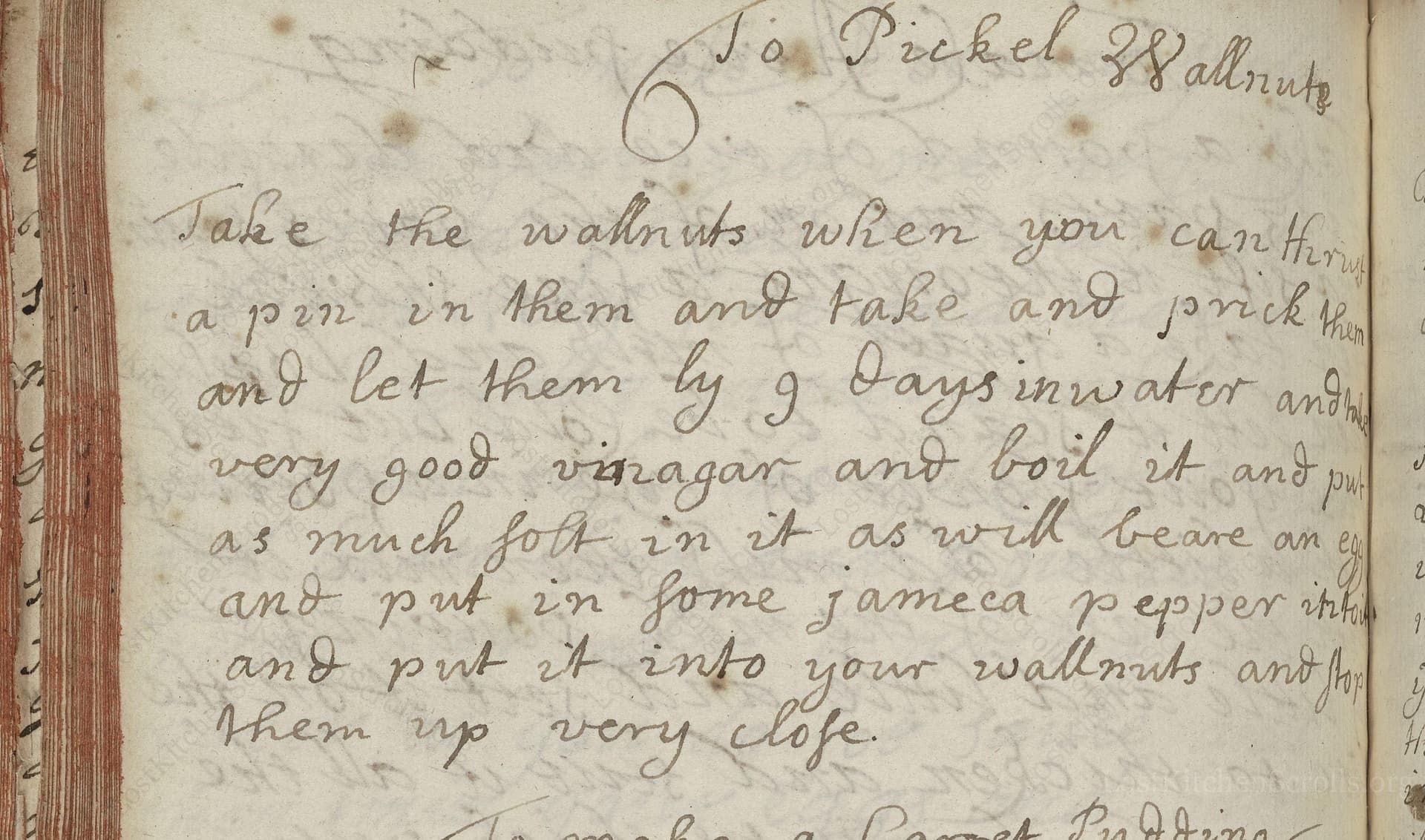To Pickel 38 Wallnuts
From the treasured pages of Cookbook of Constance Hall
Written by Constance Hall

To Pickel 38 Wallnuts
"Take the wallnuts when you can a pin in them and take and prick them and let them by 9 Days inwater and very good vinagar and boil it and put as much foth in it as will beare an egg and put in fome jameca pepper into and put it into your wallnuts and ftop Them up very clofe."
Note on the Original Text
This recipe exemplifies early modern English culinary writing—brisk and to the point, assuming domestic expertise and omitting finer measurements or timings. 17th-century spelling (‘wallnuts’, ‘fome’, ‘top up very close’) reflects non-standardized orthography, while ‘Jamaica pepper’ indicates early use of globally traded spices, now better known as allspice. Directions rely on sight and touch, favoring experience over precision, and use charming period tools (an egg to test brine strength) to guide the cook towards success.

Title
Cookbook of Constance Hall (1672)
You can also click the book image above to peruse the original tome
Writer
Constance Hall
Era
1672
Publisher
Unknown
Background
A spirited foray into 17th-century kitchens, this collection by Constance Hall brims with the flavors, secrets, and delicacies of Restoration-era England—perfect for cooks keen to revive a dash of history in their modern menus.
Kindly made available by
Folger Shakespeare Library
This recipe hails from the kitchen of Constance Hall, recorded in 1672, a time when preserving was both necessity and art. The English gentry and their households prized pickled green walnuts as a savory and piquant accompaniment to rich meats and cheeses, especially in winter months when fresh produce was scarce. 'V.a.20' refers to a manuscript collection of recipes and remedies kept by households like Hall’s, revealing not just culinary preferences but the resourcefulness and interconnectedness of early modern English domestic life.

In Hall's 17th-century kitchen, cooks would use earthenware bowls or wooden tubs for soaking the walnuts, a sharp steel pin or embroidery needle to prick them, and a brass or copper pan to bring the vinegar brine to a boil. Preservation jars or stoneware pots (sealed with cloth and wax or tightly fitted lids) would protect the pickled nuts from spoilage. A simple skimmer was used to remove froth ('foth'), and measuring was done by practical tests, like floating an egg to check brine salinity—a time-tested household trick.
Prep Time
30 mins
Cook Time
10 mins
Servings
9
We've done our best to adapt this historical recipe for modern kitchens, but some details may still need refinement. We warmly welcome feedback from fellow cooks and culinary historians — your insights support the entire community!
Ingredients
- 38 young green walnuts (about 2.2 lbs)
- 1 quart water
- 1.6 quarts good-quality wine vinegar (or cider vinegar)
- 3.5 oz sea salt (plus extra if needed to float an egg)
- 5-10 allspice berries (Jamaica pepper; substitute with allspice if Jamaica pepper unavailable)
Instructions
- Begin with 38 young green walnuts, harvested when still tender enough to pierce with a pin (typically late spring to early summer).
- Prick each walnut with a clean needle or skewer to help the brine penetrate.
- Soak the walnuts in a mixture of cold water and good-quality vinegar—enough to fully cover them—for 9 days, changing the brine regularly to keep everything fresh.
- Next, prepare a fresh batch of vinegar and bring it to the boil.
- To this, add salt until an egg will float (about 3.5 oz salt per 1 quart of vinegar).
- Add a few allspice berries (modern substitute for Jamaica pepper) to the hot vinegar.
- Pour this spiced, hot brine over your drained walnuts, ensuring they are completely submerged.
- Seal in sterilized jars while hot and store in a cool, dark place for several weeks before enjoying with cheese or cold meats.
Estimated Calories
25 per serving
Cooking Estimates
It takes about 30 minutes to prepare the walnuts for soaking, and the brining and soaking steps together take 9 days. The actual cooking time is short when boiling the vinegar. Each serving is based on about 4 walnuts, and calories per serving are very low since these are mostly pickled walnuts without added sugar.
As noted above, we have made our best effort to translate and adapt this historical recipe for modern kitchens, taking into account ingredients nowadays, cooking techniques, measurements, and so on. However, historical recipes often contain assumptions that require interpretation.
We'd love for anyone to help improve these adaptations. Community contributions are highly welcome. If you have suggestions, corrections, or cooking tips based on your experience with this recipe, please share them below.
Join the Discussion
Rate This Recipe
Dietary Preference
Main Ingredients
Culinary Technique

Den Bockfisch In Einer Fleisch Suppen Zu Kochen
This recipe hails from a German manuscript cookbook compiled in 1696, a time whe...

Die Grieß Nudlen Zumachen
This recipe comes from a rather mysterious manuscript cookbook, penned anonymous...

Ein Boudain
This recipe comes from an anonymous German-language manuscript cookbook from 169...

Ein Gesaltzen Citroni
This recipe, dating from 1696, comes from an extensive anonymous German cookbook...
Browse our complete collection of time-honored recipes



